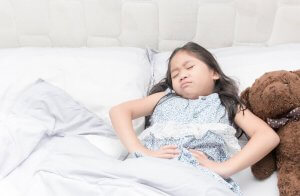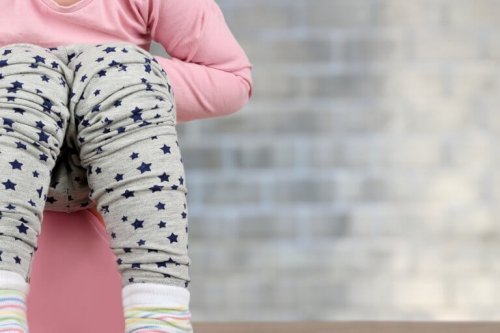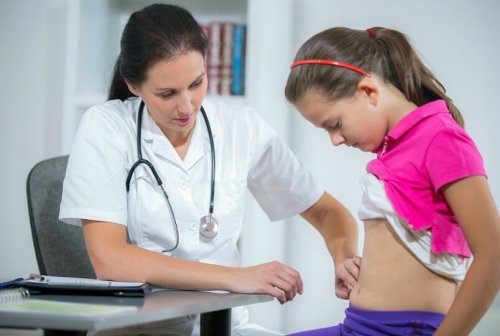Cystitis in Girls: Symptoms, Prevention and Treatment

Cystitis is a urine infection that mostly affects women. Cystitis in girls can be contracted from early ages and throughout life.
Men can also suffer from this disease, but there’s less possibility of a urinary infection when compared to women. The probability of infection in girls compared to boys is 10 versus 1. In breastfed babies, the proportion is 2 versus 1.
The reason why there’s an increased risk of cystitis in girls is that their urethra is shorter, which facilitates the entry of germs into the body. Moreover, the chances of infection increase when hygiene isn’t adequate.
The microbes that cause the appearance of cystitis are the Escherichia coli – germs that are found in feces. Other bacteria that reproduce by not keeping the vaginal area dry and sanitary are streptococci and staphylococci.
You can detect this infection rather easily by its symptoms and you must follow a simple treatment to cure it. There are different signs that will alert you of the existence of this disease; this will enable you to go to a doctor quickly and avoid possible problems by not diagnosing it on time.
Symptoms of cystitis in girls
One of the first symptoms is that the girl is permanently eager to urinate and shows that she’s suffering from pain or burning. At the same time, when she pees, she only manages to expel a few drops of urine, sometimes with blood.
In the case of babies, diapers are usually lightly wet and with traces of pink pee. Also, if you observe that the baby cries unfoundedly, isn’t hungry, and vomits, it’s necessary to visit the pediatrician as soon as possible.
Be aware of the girl’s behavior to detect these symptoms in time. Lack of diagnosis at the right moment can lead to pyelonephritis – an infection in the kidneys.
When facing pyelonephritis, the symptoms will be: fever, vomiting, chills, severe pain in the belly, and red skin. It’s necessary to go urgently to the doctor the moment that the girl suffers any of these symptoms.

Proper treatment
The treatment that doctors prescribe is usually based on antibiotics to attack the bacteria, and anti-inflammatories to relieve pain or burning. Normally, prescribing the most appropriate antibiotic also requires a urinalysis.
The duration of the illness is from one week to ten days. The first days are the most complicated due to the inconveniences that arise. It’s mandatory to comply with the right dosage for proper healing, otherwise, episodes are likely to repeat themselves.
Likewise, constant hydration is essential to eliminate toxins quicker and to dilute the urine. This will help the expulsion of germs and the emptying of the girl’s bladder.
“The reason why there’s an increased risk of cystitis in girls is that their urethra is shorter, which facilitates the entry of germs into the body.”
How to avoid cystitis in girls?
There are several recommendations to alleviate girls who have cystitis, which also prevents them from contracting it in the future. With that in mind, the following tips will be useful:
- Hydration: it’s necessary to drink a lot of liquid, such as water, natural juices, cranberry juice, broths with vegetables, etc. These products will help eliminate toxins.
- Don’t hold the urge to urinate: you have to teach girls to go to the bathroom regularly. By doing this, they avoid the risk of bacteria that grow easily in urine.

- Avoid fatty foods: They’re difficult to purify and hinder the elimination of urine.
- Properly sanitize the perianal area: you have to teach girls to clean themselves from the vagina to the anal area. The objective is to avoid the transfer of germs.
- Keep underwear dry and clean: humidity favors the colonization of bacteria.
- Change diapers frequently: in babies, it’s necessary to keep them clean and dry most of the time.
- Avoid foam baths: soap can irritate the urethral area and increase the chances of a urinary infection.
- Put on comfortable clothes: buying cotton underwear will ensure air circulation and avoid irritation and moisture in the vaginal area.
Cystitis in girls is a disease that must be diagnosed and treated, but it doesn’t represent a major problem. With these simple hygiene recommendations, you can avoid future illnesses.
Cystitis is a urine infection that mostly affects women. Cystitis in girls can be contracted from early ages and throughout life.
Men can also suffer from this disease, but there’s less possibility of a urinary infection when compared to women. The probability of infection in girls compared to boys is 10 versus 1. In breastfed babies, the proportion is 2 versus 1.
The reason why there’s an increased risk of cystitis in girls is that their urethra is shorter, which facilitates the entry of germs into the body. Moreover, the chances of infection increase when hygiene isn’t adequate.
The microbes that cause the appearance of cystitis are the Escherichia coli – germs that are found in feces. Other bacteria that reproduce by not keeping the vaginal area dry and sanitary are streptococci and staphylococci.
You can detect this infection rather easily by its symptoms and you must follow a simple treatment to cure it. There are different signs that will alert you of the existence of this disease; this will enable you to go to a doctor quickly and avoid possible problems by not diagnosing it on time.
Symptoms of cystitis in girls
One of the first symptoms is that the girl is permanently eager to urinate and shows that she’s suffering from pain or burning. At the same time, when she pees, she only manages to expel a few drops of urine, sometimes with blood.
In the case of babies, diapers are usually lightly wet and with traces of pink pee. Also, if you observe that the baby cries unfoundedly, isn’t hungry, and vomits, it’s necessary to visit the pediatrician as soon as possible.
Be aware of the girl’s behavior to detect these symptoms in time. Lack of diagnosis at the right moment can lead to pyelonephritis – an infection in the kidneys.
When facing pyelonephritis, the symptoms will be: fever, vomiting, chills, severe pain in the belly, and red skin. It’s necessary to go urgently to the doctor the moment that the girl suffers any of these symptoms.

Proper treatment
The treatment that doctors prescribe is usually based on antibiotics to attack the bacteria, and anti-inflammatories to relieve pain or burning. Normally, prescribing the most appropriate antibiotic also requires a urinalysis.
The duration of the illness is from one week to ten days. The first days are the most complicated due to the inconveniences that arise. It’s mandatory to comply with the right dosage for proper healing, otherwise, episodes are likely to repeat themselves.
Likewise, constant hydration is essential to eliminate toxins quicker and to dilute the urine. This will help the expulsion of germs and the emptying of the girl’s bladder.
“The reason why there’s an increased risk of cystitis in girls is that their urethra is shorter, which facilitates the entry of germs into the body.”
How to avoid cystitis in girls?
There are several recommendations to alleviate girls who have cystitis, which also prevents them from contracting it in the future. With that in mind, the following tips will be useful:
- Hydration: it’s necessary to drink a lot of liquid, such as water, natural juices, cranberry juice, broths with vegetables, etc. These products will help eliminate toxins.
- Don’t hold the urge to urinate: you have to teach girls to go to the bathroom regularly. By doing this, they avoid the risk of bacteria that grow easily in urine.

- Avoid fatty foods: They’re difficult to purify and hinder the elimination of urine.
- Properly sanitize the perianal area: you have to teach girls to clean themselves from the vagina to the anal area. The objective is to avoid the transfer of germs.
- Keep underwear dry and clean: humidity favors the colonization of bacteria.
- Change diapers frequently: in babies, it’s necessary to keep them clean and dry most of the time.
- Avoid foam baths: soap can irritate the urethral area and increase the chances of a urinary infection.
- Put on comfortable clothes: buying cotton underwear will ensure air circulation and avoid irritation and moisture in the vaginal area.
Cystitis in girls is a disease that must be diagnosed and treated, but it doesn’t represent a major problem. With these simple hygiene recommendations, you can avoid future illnesses.
All cited sources were thoroughly reviewed by our team to ensure their quality, reliability, currency, and validity. The bibliography of this article was considered reliable and of academic or scientific accuracy.
- Cistitis no complicada en la mujer Guía Multidisciplinar – Actualización 2017. https://www.aeu.es/UserFiles/files/GUIA_ITU_2017_CAST_42_v04.pdf
- Diego, L., Robert, L., Pellicer, À., Rodríguez, G., Rosich, I., & Ribes, E. CISTITIS NO COMPLICADA EN MUJERES: 5 ESTRATEGIAS PARA MEJORAR LA PRESCRIPCIÓN. http://medicaments.gencat.cat/web/.content/minisite/medicaments/professionals/butlletins/boletin_informacion_terapeutica/documents/arxius/BIT-2-2020-cistitis-no-complicada-mujeres.pdf
- Salazar Díaz, A. (2017). Probióticos y salud. https://eprints.ucm.es/id/eprint/55393/
This text is provided for informational purposes only and does not replace consultation with a professional. If in doubt, consult your specialist.








